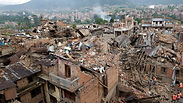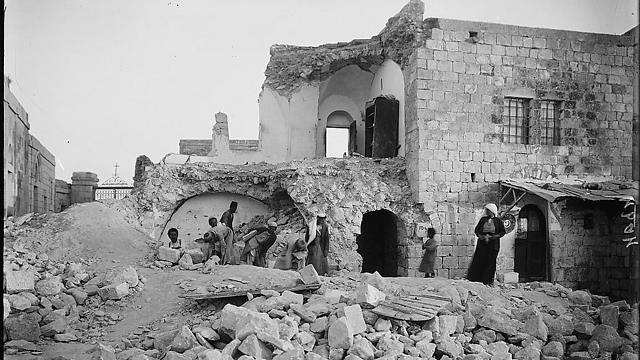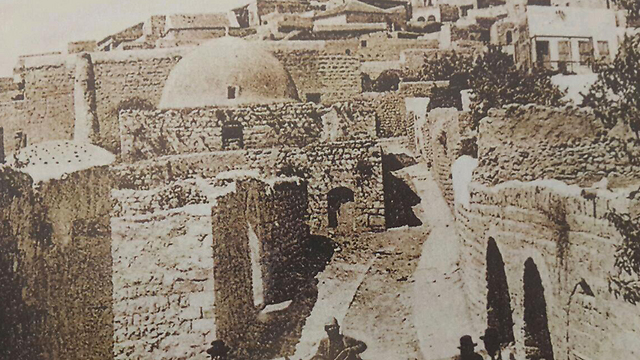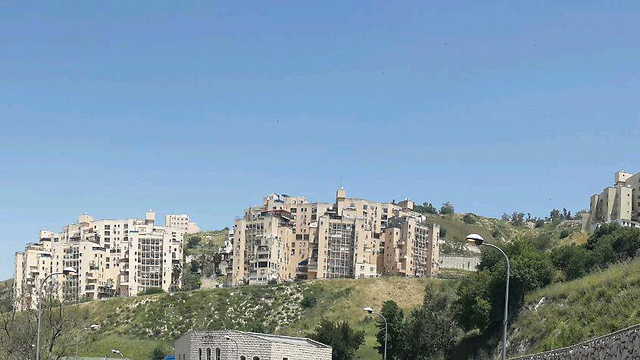
Experts: Israel vulnerable to quake damage
An earthquake hits the region roughly once a century but buildings constructed before 1982 are not up to legal standards -- and this is being rectified chiefly in places that need it less.
The earthquake that killed thousands in Nepal last Saturday is a potent reminder of how important it is for a nation to adequately prepare for natural disasters – and experts warn that Israel's infrastructure is solely lacking in this respect.
In the wake of the images of destruction and devastation coming out of Nepal, the question once again arises: What would have happened if an earthquake struck Israel today?
In 2011, the state comptroller released a report alerting on a possible disaster that could claim the lives of some 15,000 people and cause the collapse of hundreds of thousands of structures.
Over the past 1000 years, there were eight strong earthquakes in the area, most of them 6-6.6 on the Richter scale.
"They happened in a cycle of one every 100 years," said Prof. Moshe Inbar, an expert on natural disasters from Haifa University. "These weren't quakes like the one in Nepal, and still they claimed thousands of lives. In 1995 there was a 7-magnitude earthquake in the depths of the Dead Sea, over 100 km from Eilat, and the city still experienced damage. If such a quake hits inside the borders of the State of Israel, the damage could be much greater."
The testimony of a resident of Tiberias from the earthquake that destroyed the city in 1837 paints a picture of the utter destruction previously experienced in the area.
"The ground moved under me. Pieces of rocks rolled down the mountains. Full of fear, I looked at the city below, where my most dear were - my husband and children. Dear God! I never got to see them again! I looked at the city walls, cracks created in them. Everything moved back and forth. I could not see a thing except for a thick and dark dust cloud that covered the entire city. Then, I heard a sound like thunder, and screams and cries of horror from the mouths of thousands.
"I fainted, falling to the ground. While the cracks in the city wall broke, panicked residents carrying some of their property, or their wounded relatives, or the body of a shattered man, also broke free. The entire city was in ruins. I worked all night to roll the rocks off the corpses of my children. My fingers were bloodied. No one helped me."
The earthquake in Tiberias and Safed, which was 6.6-magnitude on the Richter scale, happened at 5 pm on Sunday, January 1, 1837.
A devastating earthquake in our region can only occur along the East African Rift, but it's hard to predict the outcome of such a quake as the amount of damage depends on construction standards.
A construction bill meant to address to such a scenario was passed in 1980, but only started being enforced two years later.
According to the Construction Ministry, there are some 810,000 housing units that are not up to the standard set in the 1980 legislation.
"You can say anything built after that is okay," Prof. Inbar explained. "The problem is there is older construction in areas and cities close to the East Africa Rift: In the lower areas of Tiberias, in Beit She'an, in areas of Safed not built on rocks, in Kiryat Shmona and of course in Eilat. The situation in Eilat is even more concerning because the hotels area is built on alluvium soil, the kind that increases Seismic waves."
As terrifying as that sounds, Prof. Inbar is actually one of the optimists among the experts regarding the chances of rehabilitation following an earthquake, despite the devastating damage they leave behind.
On the other hand, other experts dealing with population behavior and ways of handling populations after natural disasters warn that Israel is not prepared to handle a disaster of catastrophic scale.
"It's all a matter of resources," explained Prof. Avi Kirshenbaum, an expert in disaster management from the Haifa University. "How many ambulances are in each city? How many firefighters? How many scenes can they handle at the same time? And if the injured are evacuated to hospital, who will treat them? Can medical teams even reach hospitals? It's an event on a scale no one in Israel understands.
"Our numbers indicate that at 6-magnitude earthquake, some 90 percent of structures in the country not built according to the 1980 legislation will collapse. These are the massive train structures built in the fifties and structures built in the seventies on pillars. Hundreds of thousands of people live in these structures.
"Imagine the massive amount of casualties on the streets, that could not be identified, evacuated or buried in the first stage, or the massive number of injured who will have no one to treat them. Water, electricity, sewage and gas infrastructure would also collapse, not to mention communication infrastructure. The main problem, as I see it, would be the water supply.
"The bottom and only line in dealing with such an event, and we need to internalize this, is every man for himself. No one will come to help us. There's no one to count on at least in the first three days after the disaster, and even then the Home Front Command would not be able to reach any point and any site of wreckage. Even the Home Front Command has realized and admitted this, and has begun training people in communities and local forces to deal with destruction and with immediate search and rescue."
In tandem with Dr. Carmit Rappaport, coordinator of Haifa University's Emergency and Disaster Management Program, and Professor Dafna Canetti of the university's School of Political Science, Kirschenbaum recently held a survey showing that more than 50 per cent of Israelis feel they lack the knowledge and tools to handle an earthquake scenario. About 60 per cent of the public feels that authorities are only partly capable of dealing with such a catastrophe.
The study found that citizens who have been exposed to terrorist incidents or rocket fire feel much more prepared. "They have prepared bags, equipment, checked the state of their homes and so on," said Professor Canetti.
"Even if damage is repaired, and that will take several years, the difficult experiences will not allow people to return to something called a routine," said Professor Kirschenbaum.
Safed Mayor Ilan Shohat, whose city has twice been damaged by serious earthquakes in past centuries that killed thousands, recently voiced his concern about another destructive earthquake. "I haven't slept night for several nights in light of the images from Nepal," he said. "Statistics are not in our favor, and if, heaven forbid, something like this happens in our area – the sights will be no less difficult."
The mayor noted that the city was built upon layers of rubble. He warned that the city was not prepared to meet the threat of a major disaster.
"We do not have enough equipment and supplies to function independently for a week without communication with the outside world," said Shohat.
Shohat successfully proposed to send mayors and defense officers in the next mission to Nepal, in order to implant awareness of earthquake conditions. "We haven't experienced it, it's all on paper. To experience it physically is a very important element of being prepared," he said.
Hospitals in the north are a weak point in the earthquake response system. A 2011 state comptroller report laid out a series of defects that could cause some of them to collapse in the event of a severe quake.
National outline plan 38 – an overarching plan to bolster existing structures against earthquakes – suffers from obstacles and wide-ranging problems, not least the fact that it's mainly implemented in central Israel rather than closer to the East African Rift.
"An earthquake is not a catastrophe," explained Col. (Res.) Hilik Sofer, an expert on earthquakes and national outline plan 38. "What turns the quake into a catastrophe is how we build our homes and infrastructure." The state, he said, has left implementation of the plan to the inhabitants. "Essentially those who set the tone are the contractors and developers. And where do they go? Where there's the most profit: Tel Aviv, Givatayim, central Israel.
Tel Aviv Mayor Ron Huldai spoke out against plan 38 in April, saying it was "a plan born in sin" and that it should be implemented in areas that are at risk, along the East African Rift. "The plan is a gift to the rich at the expense of the poor."
Michal Margalit and Ilana Curiel contributed to this report.













